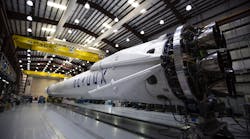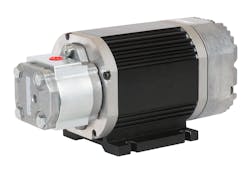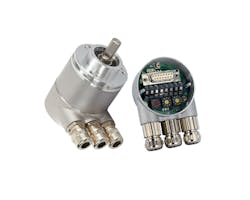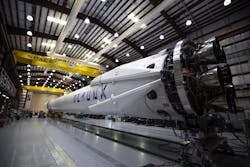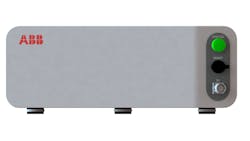The motion control industry is a sub-sector of automation encompassing the moving components of machinery. As it advances, so does the productivity of the associated equipment. Here are four examples of new motion control products filled with notable features.
Allied Motion EHS Series Electrohydraulic Pump Drive Motors
Electrohydraulic pumps are crucial parts of the power steering systems on trucks and buses. Allied Motion is a company headquartered in Amherst, New York, that has a global reach.
With its EHS Series of brushless drive motors for electrohydraulic pumps, the brand offers pump motors that directly propel the electronic parts on commercial vehicles.
In contrast to entirely hydraulic solutions, the electric power steering solutions provided by the EHS Series result in substantial fuel efficiency improvements plus more design flexibility. Clients also have the option to order them with integrated hydraulic pumps.
The pump motors in the EHS Series have onboard electronics that let the motor act as an intelligent node in networks of other modern vehicles. Then, it’s possible to set work modes, bitrates and more through programming. Depending on the model selected, these drive motors have an output power range of 0.6 to 1.75 kilowatts.
Moreover, these pump motors are engineered and carefully tested to ensure excellent durability and long lifespans even in harsh conditions. As such, buyers can look forward to reduced overall maintenance and repair expenses compared with all-hydraulic options.
The products in the EHS Series are primarily meant for large vehicles such as buses and heavy trucks. However, other potential applications include agricultural equipment and lift trucks that have hydraulic steering.
POSITAL IXARC Magnetic Absolute Encoders
Magnetic encoders convert angles or other positional data into digital or analog signals for use in motion control applications. They collect data to send to encoder engines, which transmit the respective signals to the motion control application.
A magnetic encoder determines rotary positions with a magnetic field. It features a magnetized wheel spinning over a plate full of magneto-resistive sensors. The strength of a magnetic field causes changes in the responses of those sensors. Then, the magnetic output gets sent through a signal conditioning electrical circuit.
Absolute encoders start giving positional details as soon as an operator switches them on because all possible positions correspond to unique codes, and a scanner detects which is applicable at any given moment in time.
The new magnetic absolute encoders from POSITAL’s IXARC line that have CANopen interfaces offer an optional connection cap that simplifies device configurations and troubleshooting. CANopen is a high-level communication protocol and device specification relevant to embedded systems in automation.
Previous versions of IXARC magnetic controllers with CANopen interfaces provided by POSITAL required updates to software parameters, which meant companies had to recruit people with specialized expertise. In contrast, the connection caps have three rotary switches an installer can manipulate with a small screwdriver to define the node ID and baud rate, the latter relating to the speed of communication over a data channel.
The eight screw terminals on the rear of the encoder allow cable installation. Plus, diagnostic LEDs on the back of the cap show the device and network status, enabling efficient installation and debugging on these Ethernet-compatible parts.
In comparison to optical encoders that determine rotary positioning with light, these magnetic absolute encoders with the connection caps are 30 percent smaller. They also boast superior resistance to shocks and vibrations.
Purchasers can either buy single or multi-turn versions of these magnetic encoders. In the case of the multi-turn options, they have self-powered rotation counters and do not require battery backup systems. Moreover, those possibilities offer a measurement range of 4 billion revolutions.
Marotta CoRe Flow Control Series of Solenoid Valves
Since the 1940s, Marotta and its specialty components have been instrumental in over 50 space programs. A solenoid valve controls the flow of gases and liquids involved in the equipment. These valves permit or shut off the flow or mix during operation.
Marotta offers a product collection of pilot-operated and direct-acting solenoid valves. The pilot-operated type relies on the differential pressure of the medium over the valve ports to open and shut. That means they require pressure to stay closed. In contrast, the direct-acting solenoid valves remain closed even without applied force. The voltage range of these solenoid valves is 18-32 VDC across the product line.
There are six options in the CoRe Flow Control Series, all designed for commercial space launch vehicle applications. These components are dependable and high-performance, yet affordable. Because each of these solenoid valves includes readily available, frequently produced products, they’re available to customers after shorter-than-average lead times compared with competitors.
Each of these solenoid valves made by Marotta must pass a seven-stage acceptance test-based quality-control process before leaving the manufacturing facility. Plus, the valve assemblies have serial numbers that connect to the applicable acceptance test data and certificates of conformance, which are both kept on file for seven years.
Together, these features offer peace of mind to buyers. Additionally, the solenoid valves are reusable, making them cost-effective items.
ABB OmniCore Digital Robot Controllers
A digital robot controller receives inputs and adjusts its outputs accordingly. It helps connected robotics equipment function in a precise and measured manner.
Designed to meet the needs of today’s factories, this new assortment of digital robot controllers from ABB works in a setting where factory owners and managers require 24/7 uninterrupted operation, but it’s also customizable for more specific needs, such as high-mix-low-volume (HMLV) items with short product cycles.
Besides outstanding path accuracy, these robot controllers have a 50 percent smaller footprint than other options. As a result, they fit into existing configurations with ease while catering to the needs of plant managers who want to incorporate automation into a brand-new facility and do so without taking up excessive space.
The OmniCore controller products feature ABB’s Ability platform. It aids in equipment management, remote monitoring and more.
They come with the brand’s SafeMove2 technology as well. It turns any connected industrial robot into a collaborative model that works safely yet swiftly around human employees.
SafeMove2 uses safety-certified monitoring of robotic motion parameters and a piece of equipment’s associated tools. So, it’s possible for workers to interact with robots in closer-than-expected quarters, saving space without increasing risk.
Customers can order the first of ABB’s small OmniCore Robot Controllers beginning in November 2018. Each one weighs 24 kilograms and comes with a rack-mounting kit for installation in 19-inch cabinets. Furthermore, the ambient operating temperature range of these robot controllers is between 0-45 degrees Celsius or 32-113 degrees Fahrenheit.
Motion Control Is Moving Forward
These four products demonstrate how high-tech motion control technologies can have substantial impacts on the overall performance of electromechanical processes. Although these components are relatively small, they provide features that make them appealing and appropriate for numerous applications and industries.
